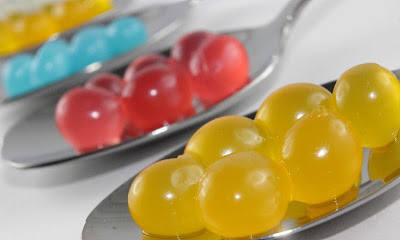Exceptional food that worth a special journey. And all other foods that can kill you.
Tuesday
How to Join Two Portions of Meat Using Transglutaminase (Meat Glue)
Transglutaminase,
an enzyme that catalyzes an acyl
transfer reaction (Gln ε Lys) to form ε-(γ-Glu)-Lys isopeptide bonds within and between proteins (formation of a covalent bond between a free amine
group), is used to promote protein functionality and bind meat particles in
restructured products. The enzyme also catalyzes
the hydrolysis of the γ-carboxyamide group in glutaminyl residues,
resulting in deamidation. In muscle foods, where protein lysine residues (acyl
acceptors) are abundant, the Gln-Lys cross-linking reaction prevails.
Transglutaminases
are a family of enzymes that bond with proteins. The reaction also produces a molecule of ammonia. Such an enzyme is
classified as EC 2.3.2.13. Bonds formed by transglutaminase exhibit high
resistance to proteolytic degradation
(proteolysis). While the enzyme can be extracted from a variety of natural
sources, MTGase produced from Streptomyces
mobaraensis (Streptoverticillium mobaraense) has attracted the
most attention.
Transglutaminases
were first described in 1959. The exact biochemical activity of
transglutaminases was discovered in blood coagulation protein factor XIII in
1968. Microbial transglutaminase (MTGase) was introduced initially by Ajinomoto
Co. to meat processing to facilitate the production of muscle protein gels and
the “bind” in restructured raw meat, including fish fillets and nuggets. MTGase
suits processed meats well as it maintains high activity over a broad pH,
temperature, and salt concentration range.
In
commercial food processing, transglutaminase is used to bond proteins together.
Examples of foods made using transglutaminase include imitation crabmeat, and fish
balls. It is produced by Streptomyces
mobaraensis (Streptoverticillium mobaraense) fermentation in
commercial quantities or extracted from animal blood, and is used in a variety
of processes.
Transglutaminase
can be used as a binding agent to improve the texture of protein-rich foods
such as surimi or ham. Chefs use this “meat glue” to bind two or more pieces
of meat such as sliced bacon wrapped around a filet steak. Unlike gelatin,
which also acts as glue, transglutaminase
doesn’t melt when heated. The instructions below shows how to “glue” two
trimmed top blade muscles, then cut them crosswise to make tender, juicy, and
relatively inexpensive double top blade steaks.
Read
the package
label before using. Each
transglutaminase is formulated for specific uses. Some are meant for fish, some
for meat, some for cooked products, some for raw. Some types are sprinkled on
the meat to be joined, others are mixed with water and brushed on. Here,
we sprinkle the meat with transglutaminase to join two top blade muscles.
Purchase transglutaminase from butcher supply companies and online retailers
like Amazon.com, here is the link... Transglutaminase or Meat Glue.
Place
two trimmed top blade muscles on a large piece of plastic wrap with their
undersides facing up and the thickest portions facing in opposite directions.
Directions:
1)
Sprinkle 1 to 2 teaspoons (5 to 10 g) of
transglutaminase powder evenly over the meat, making sure to sprinkle on the
edges.
2)
Cover one muscle with the other.
3)
Press firmly together to join the two, shaking off and discarding any
excess powder.
4)
Roll up tightly in the plastic wrap to help join the two muscles
together.
5) Wrapped top blade steaks ready to refrigerate. Refrigerate
several hours to allow the bond to form.
6) Unwrap
the steak and trim off small slices from both ends to square them off. Cut
crosswise into steaks 3/4 to 1 inch (2 to 2.5 cm) thick.
7) Double top blade steaks ready to cook.
Watch Video: Reconstructed Chicken Thigh Using Activa GS
(Transglutaminase)
Uses of Transglutaminase in Molecular Gastronomy or Modernist Cuisine
Transglutaminase is
also used in molecular gastronomy to
meld new textures with existing tastes. Besides these mainstream uses,
transglutaminase has been used to create some unusual foods. British chef Heston Blumenthal is credited with the
introduction of transglutaminase into modern cooking.
Wylie
Dufresne, chef of
New York's avant-garde restaurant wd~50,
was introduced to transglutaminase by Blumenthal, and invented a "pasta"
made from over 95% shrimp thanks to transglutaminase.
Video Lecture: Proteins and Enzymes: Transglutaminase, Watch Wylie Dufresne of wd~50
Have
you tried cooking a French recipe? Have you been to a French restaurant? Then
you already know this... 101 Common French Food Terms Pronunciation
You Must Know
Watch Video: Transglutaminase or Meat Glue is the Meat Industry
Dirty Little Secret
The Meat Glue makes
pieces of beef, lamb, chicken or fish that would normally be thrown out stick
together so closely that it looks like a solid piece of meat then sold to you
for a higher price. Buyers Beware!
References:
Ahhmed AM, Kuroda R,
Kawahara S, Ohta K, Nakadea K, Aokib K, Muguruma M. 2009. Dependence of microbial
transglutaminase on meat type in myofibrillar proteins cross-linking. Food
Chem. 112:354–61.
Castro-Briones M,
Calderón GN, Velázquez G, Rubio MS, Vázquez M, Ramírez JA. 2009. Mechanical
and functional properties of beef products obtained using microbial
transglutaminase with treatments of pre-heating followed by cold binding.
Meat Sci 83:229–38.
Cho, YH, HK Shim, and
J Park. 2003. Encapsulation of fish oil by an enzymatic gelation process using
transglutaminase cross-linked proteins. JFood Sci 68 (9).
Griffin M, Casadio R,
Bergamini CM. 2002. Transglutaminases: nature's biological glues. Biochem J 368 (Pt 2): doi:10.1042/BJ20021234. PMC 1223021.
PMID 12366374.
Kawahara S, Ahmed AM,
Ohta K, Nakade K, Muguruma M. 2007. Inconsistency in the improvements of gel
strength in chicken and pork sausage induced by transglutaminase. Asian–Aust
J Anim Sci. 20:1285–91.
Kelleher, James B.
(May 11, 2012). Industry defends ingredient critics deride as "meat glue".
Chicago Tribune.
Subscribe to:
Post Comments (Atom)

Can I use a meat glue on a piece of meat after it has been brined or marinated
ReplyDeleteIt is better to glue it first, then you can marinate or brine the meat.
Delete